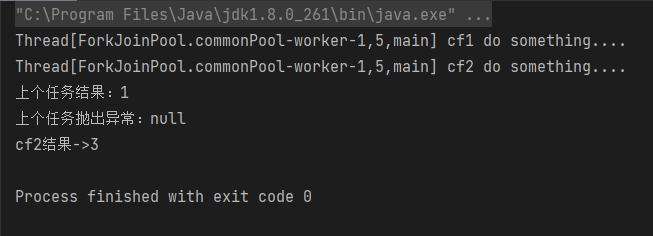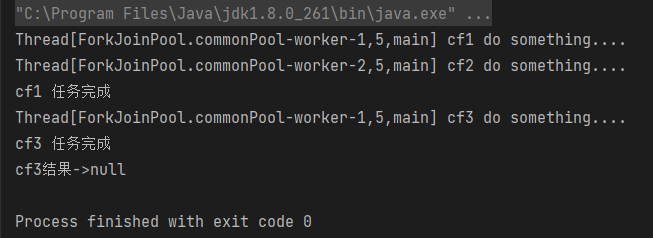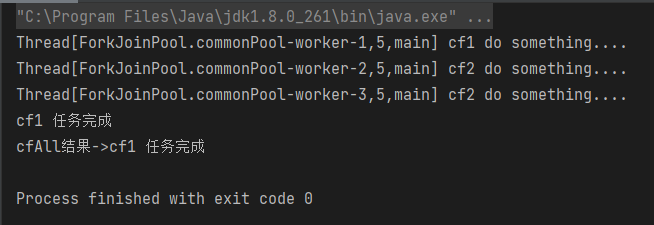CompletableFuture是jdk8的新特性。CompletableFuture实现了CompletionStage接口和Future接口,前者是对后者的一个扩展,增加了异步会点、流式处理、多个Future组合处理的能力,使Java在处理多任务的协同工作时更加顺畅便利。
一、创建异步任务 1. supplyAsync supplyAsync是创建带有返回值的异步任务。它有如下两个方法,一个是使用默认线程池(ForkJoinPool.commonPool())的方法,一个是带有自定义线程池的重载方法
1 2 3 4 5 public static <U> CompletableFuture<U> supplyAsync (Supplier<U> supplier) public static <U> CompletableFuture<U> supplyAsync (Supplier<U> supplier, Executor executor)
测试代码:
1 2 3 4 5 6 7 8 9 10 11 12 13 14 15 16 17 18 19 20 21 22 public static void main (String[] args) throws ExecutionException, InterruptedException { CompletableFuture<String> cf = CompletableFuture.supplyAsync(() -> { System.out.println("do something...." ); return "result" ; }); System.out.println("结果->" + cf.get()); } public static void main (String[] args) throws ExecutionException, InterruptedException { ExecutorService executorService = Executors.newSingleThreadExecutor(); CompletableFuture<String> cf = CompletableFuture.supplyAsync(() -> { System.out.println("do something...." ); return "result" ; }, executorService); System.out.println("结果->" + cf.get()); }
测试结果:
2. runAsync runAsync是创建没有返回值的异步任务。它有如下两个方法,一个是使用默认线程池(ForkJoinPool.commonPool())的方法,一个是带有自定义线程池的重载方法
1 2 3 4 5 public static CompletableFuture<Void> runAsync (Runnable runnable) public static CompletableFuture<Void> runAsync (Runnable runnable, Executor executor)
测试代码:
1 2 3 4 5 6 7 8 9 10 11 12 13 14 15 16 17 18 19 20 public static void main (String[] args) throws ExecutionException, InterruptedException { CompletableFuture<Void> cf = CompletableFuture.runAsync(() -> { System.out.println("do something...." ); }); System.out.println("结果->" + cf.get()); } public static void main (String[] args) throws ExecutionException, InterruptedException { ExecutorService executorService = Executors.newSingleThreadExecutor(); CompletableFuture<Void> cf = CompletableFuture.runAsync(() -> { System.out.println("do something...." ); }, executorService); System.out.println("结果->" + cf.get()); }
测试结果:
3.获取任务结果的方法 1 2 3 4 5 6 7 8 9 10 11 12 13 14 15 16 17 18 public T get () throws InterruptedException, ExecutionException public T get (long timeout, TimeUnit unit) throws InterruptedException, ExecutionException, TimeoutException public T join () public T getNow (T valueIfAbsent) public boolean complete (T value) public boolean completeExceptionally (Throwable ex)
二、异步回调处理 1. thenApply和thenApplyAsync thenApply 表示某个任务执行完成后执行的动作,即回调方法,会将该任务的执行结果即方法返回值作为入参传递到回调方法中,带有返回值。
测试代码:
1 2 3 4 5 6 7 8 9 10 11 12 13 14 15 16 17 18 19 20 21 22 23 24 25 26 27 28 29 30 31 32 33 public static void main (String[] args) throws ExecutionException, InterruptedException { CompletableFuture<Integer> cf1 = CompletableFuture.supplyAsync(() -> { System.out.println(Thread.currentThread() + " cf1 do something...." ); return 1 ; }); CompletableFuture<Integer> cf2 = cf1.thenApplyAsync((result) -> { System.out.println(Thread.currentThread() + " cf2 do something...." ); result += 2 ; return result; }); System.out.println("cf1结果->" + cf1.get()); System.out.println("cf2结果->" + cf2.get()); } public static void main (String[] args) throws ExecutionException, InterruptedException { CompletableFuture<Integer> cf1 = CompletableFuture.supplyAsync(() -> { System.out.println(Thread.currentThread() + " cf1 do something...." ); return 1 ; }); CompletableFuture<Integer> cf2 = cf1.thenApply((result) -> { System.out.println(Thread.currentThread() + " cf2 do something...." ); result += 2 ; return result; }); System.out.println("cf1结果->" + cf1.get()); System.out.println("cf2结果->" + cf2.get()); }
测试结果:
从上面代码和测试结果我们发现thenApply和thenApplyAsync区别在于,使用thenApply方法时子任务与父任务使用的是同一个线程,而thenApplyAsync在子任务中是另起一个线程执行任务,并且thenApplyAsync可以自定义线程池,默认的使用ForkJoinPool.commonPool()线程池。
2. thenAccept和thenAcceptAsync thenAccep表示某个任务执行完成后执行的动作,即回调方法,会将该任务的执行结果即方法返回值作为入参传递到回调方法中,无返回值。
测试代码
1 2 3 4 5 6 7 8 9 10 11 12 13 14 15 16 17 18 19 20 21 22 23 24 25 26 27 28 29 30 31 32 public static void main (String[] args) throws ExecutionException, InterruptedException { CompletableFuture<Integer> cf1 = CompletableFuture.supplyAsync(() -> { System.out.println(Thread.currentThread() + " cf1 do something...." ); return 1 ; }); CompletableFuture<Void> cf2 = cf1.thenAccept((result) -> { System.out.println(Thread.currentThread() + " cf2 do something...." ); }); System.out.println("cf1结果->" + cf1.get()); System.out.println("cf2结果->" + cf2.get()); } public static void main (String[] args) throws ExecutionException, InterruptedException { CompletableFuture<Integer> cf1 = CompletableFuture.supplyAsync(() -> { System.out.println(Thread.currentThread() + " cf1 do something...." ); return 1 ; }); CompletableFuture<Void> cf2 = cf1.thenAcceptAsync((result) -> { System.out.println(Thread.currentThread() + " cf2 do something...." ); }); System.out.println("cf1结果->" + cf1.get()); System.out.println("cf2结果->" + cf2.get()); }
测试结果:
从上面代码和测试结果我们发现thenAccep和thenAccepAsync区别在于,使用thenAccep方法时子任务与父任务使用的是同一个线程,而thenAccepAsync在子任务中可能是另起一个线程执行任务,并且thenAccepAsync可以自定义线程池,默认的使用ForkJoinPool.commonPool()线程池。
3.thenRun和thenRunAsync thenRun表示某个任务执行完成后执行的动作,即回调方法,无入参,无返回值。
测试代码:
1 2 3 4 5 6 7 8 9 10 11 12 13 14 15 16 17 18 19 20 21 22 23 24 25 26 27 28 29 30 31 public static void main(String[] args) throws ExecutionException, InterruptedException { CompletableFuture<Integer> cf1 = CompletableFuture.supplyAsync(() -> { System.out.println(Thread.currentThread() + " cf1 do something...."); return 1; }); CompletableFuture<Void> cf2 = cf1.thenRun(() -> { System.out.println(Thread.currentThread() + " cf2 do something...."); }); //等待任务1执行完成 System.out.println("cf1结果->" + cf1.get()); //等待任务2执行完成 System.out.println("cf2结果->" + cf2.get()); } public static void main(String[] args) throws ExecutionException, InterruptedException { CompletableFuture<Integer> cf1 = CompletableFuture.supplyAsync(() -> { System.out.println(Thread.currentThread() + " cf1 do something...."); return 1; }); CompletableFuture<Void> cf2 = cf1.thenRunAsync(() -> { System.out.println(Thread.currentThread() + " cf2 do something...."); }); //等待任务1执行完成 System.out.println("cf1结果->" + cf1.get()); //等待任务2执行完成 System.out.println("cf2结果->" + cf2.get()); }
测试结果:
从上面代码和测试结果我们发现thenRun和thenRunAsync区别在于,使用thenRun方法时子任务与父任务使用的是同一个线程,而thenRunAsync在子任务中可能是另起一个线程执行任务,并且thenRunAsync可以自定义线程池,默认的使用ForkJoinPool.commonPool()线程池。
4.whenComplete和whenCompleteAsync whenComplete是当某个任务执行完成后执行的回调方法,会将执行结果或者执行期间抛出的异常传递给回调方法,如果是正常执行则异常为null,回调方法对应的CompletableFuture的result和该任务一致,如果该任务正常执行,则get方法返回执行结果,如果是执行异常,则get方法抛出异常。
测试代码:
1 2 3 4 5 6 7 8 9 10 11 12 13 14 15 16 17 18 public static void main (String[] args) throws ExecutionException, InterruptedException { CompletableFuture<Integer> cf1 = CompletableFuture.supplyAsync(() -> { System.out.println(Thread.currentThread() + " cf1 do something...." ); int a = 1 /0 ; return 1 ; }); CompletableFuture<Integer> cf2 = cf1.whenComplete((result, e) -> { System.out.println("上个任务结果:" + result); System.out.println("上个任务抛出异常:" + e); System.out.println(Thread.currentThread() + " cf2 do something...." ); }); System.out.println("cf2结果->" + cf2.get()); }
测试结果:
whenCompleteAsync和whenComplete区别也是whenCompleteAsync可能会另起一个线程执行任务,并且thenRunAsync可以自定义线程池,默认的使用ForkJoinPool.commonPool()线程池。
5.handle和handleAsync 跟whenComplete基本一致,区别在于handle的回调方法有返回值。
测试代码:
1 2 3 4 5 6 7 8 9 10 11 12 13 14 15 16 17 public static void main (String[] args) throws ExecutionException, InterruptedException { CompletableFuture<Integer> cf1 = CompletableFuture.supplyAsync(() -> { System.out.println(Thread.currentThread() + " cf1 do something...." ); return 1 ; }); CompletableFuture<Integer> cf2 = cf1.handle((result, e) -> { System.out.println(Thread.currentThread() + " cf2 do something...." ); System.out.println("上个任务结果:" + result); System.out.println("上个任务抛出异常:" + e); return result+2 ; }); System.out.println("cf2结果->" + cf2.get()); }
测试结果 :
三、多任务组合处理 1. thenCombine、thenAcceptBoth 和runAfterBoth 这三个方法都是将两个CompletableFuture组合起来处理,只有两个任务都正常完成时,才进行下阶段任务。
区别:thenCombine会将两个任务的执行结果作为所提供函数的参数,且该方法有返回值;thenAcceptBoth同样将两个任务的执行结果作为方法入参,但是无返回值;runAfterBoth没有入参,也没有返回值。注意两个任务中只要有一个执行异常,则将该异常信息作为指定任务的执行结果。
测试代码:
1 2 3 4 5 6 7 8 9 10 11 12 13 14 15 16 17 18 19 20 21 22 23 24 25 26 27 28 29 30 31 32 33 34 35 36 37 38 39 40 41 42 43 44 45 46 47 48 49 50 51 52 53 54 55 public static void main (String[] args) throws ExecutionException, InterruptedException { CompletableFuture<Integer> cf1 = CompletableFuture.supplyAsync(() -> { System.out.println(Thread.currentThread() + " cf1 do something...." ); return 1 ; }); CompletableFuture<Integer> cf2 = CompletableFuture.supplyAsync(() -> { System.out.println(Thread.currentThread() + " cf2 do something...." ); return 2 ; }); CompletableFuture<Integer> cf3 = cf1.thenCombine(cf2, (a, b) -> { System.out.println(Thread.currentThread() + " cf3 do something...." ); return a + b; }); System.out.println("cf3结果->" + cf3.get()); } public static void main (String[] args) throws ExecutionException, InterruptedException { CompletableFuture<Integer> cf1 = CompletableFuture.supplyAsync(() -> { System.out.println(Thread.currentThread() + " cf1 do something...." ); return 1 ; }); CompletableFuture<Integer> cf2 = CompletableFuture.supplyAsync(() -> { System.out.println(Thread.currentThread() + " cf2 do something...." ); return 2 ; }); CompletableFuture<Void> cf3 = cf1.thenAcceptBoth(cf2, (a, b) -> { System.out.println(Thread.currentThread() + " cf3 do something...." ); System.out.println(a + b); }); System.out.println("cf3结果->" + cf3.get()); } public static void main (String[] args) throws ExecutionException, InterruptedException { CompletableFuture<Integer> cf1 = CompletableFuture.supplyAsync(() -> { System.out.println(Thread.currentThread() + " cf1 do something...." ); return 1 ; }); CompletableFuture<Integer> cf2 = CompletableFuture.supplyAsync(() -> { System.out.println(Thread.currentThread() + " cf2 do something...." ); return 2 ; }); CompletableFuture<Void> cf3 = cf1.runAfterBoth(cf2, () -> { System.out.println(Thread.currentThread() + " cf3 do something...." ); }); System.out.println("cf3结果->" + cf3.get()); }
测试结果:
2.applyToEither、acceptEither和runAfterEither 这三个方法和上面一样也是将两个CompletableFuture组合起来处理,当有一个任务正常完成时,就会进行下阶段任务。
区别:applyToEither会将已经完成任务的执行结果作为所提供函数的参数,且该方法有返回值;acceptEither同样将已经完成任务的执行结果作为方法入参,但是无返回值;runAfterEither没有入参,也没有返回值。
测试代码:
1 2 3 4 5 6 7 8 9 10 11 12 13 14 15 16 17 18 19 20 21 22 23 24 25 26 27 28 29 30 31 32 33 34 35 36 37 38 39 40 41 42 43 44 45 46 47 48 49 50 51 52 53 54 55 56 57 58 59 60 61 62 63 64 65 66 67 68 69 70 71 72 73 74 75 76 77 78 79 80 81 82 83 84 85 86 87 88 89 90 public static void main (String[] args) throws ExecutionException, InterruptedException { CompletableFuture<String> cf1 = CompletableFuture.supplyAsync(() -> { try { System.out.println(Thread.currentThread() + " cf1 do something...." ); Thread.sleep(2000 ); } catch (InterruptedException e) { e.printStackTrace(); } return "cf1 任务完成" ; }); CompletableFuture<String> cf2 = CompletableFuture.supplyAsync(() -> { try { System.out.println(Thread.currentThread() + " cf2 do something...." ); Thread.sleep(5000 ); } catch (InterruptedException e) { e.printStackTrace(); } return "cf2 任务完成" ; }); CompletableFuture<String> cf3 = cf1.applyToEither(cf2, (result) -> { System.out.println("接收到" + result); System.out.println(Thread.currentThread() + " cf3 do something...." ); return "cf3 任务完成" ; }); System.out.println("cf3结果->" + cf3.get()); } public static void main (String[] args) throws ExecutionException, InterruptedException { CompletableFuture<String> cf1 = CompletableFuture.supplyAsync(() -> { try { System.out.println(Thread.currentThread() + " cf1 do something...." ); Thread.sleep(2000 ); } catch (InterruptedException e) { e.printStackTrace(); } return "cf1 任务完成" ; }); CompletableFuture<String> cf2 = CompletableFuture.supplyAsync(() -> { try { System.out.println(Thread.currentThread() + " cf2 do something...." ); Thread.sleep(5000 ); } catch (InterruptedException e) { e.printStackTrace(); } return "cf2 任务完成" ; }); CompletableFuture<Void> cf3 = cf1.acceptEither(cf2, (result) -> { System.out.println("接收到" + result); System.out.println(Thread.currentThread() + " cf3 do something...." ); }); System.out.println("cf3结果->" + cf3.get()); } public static void main (String[] args) throws ExecutionException, InterruptedException { CompletableFuture<String> cf1 = CompletableFuture.supplyAsync(() -> { try { System.out.println(Thread.currentThread() + " cf1 do something...." ); Thread.sleep(2000 ); } catch (InterruptedException e) { e.printStackTrace(); } System.out.println("cf1 任务完成" ); return "cf1 任务完成" ; }); CompletableFuture<String> cf2 = CompletableFuture.supplyAsync(() -> { try { System.out.println(Thread.currentThread() + " cf2 do something...." ); Thread.sleep(5000 ); } catch (InterruptedException e) { e.printStackTrace(); } System.out.println("cf2 任务完成" ); return "cf2 任务完成" ; }); CompletableFuture<Void> cf3 = cf1.runAfterEither(cf2, () -> { System.out.println(Thread.currentThread() + " cf3 do something...." ); System.out.println("cf3 任务完成" ); }); System.out.println("cf3结果->" + cf3.get()); }
测试结果:
从上面可以看出cf1任务完成需要2秒,cf2任务完成需要5秒,使用applyToEither组合两个任务时,只要有其中一个任务完成时,就会执行cf3任务,显然cf1任务先完成了并且将自己任务的结果传值给了cf3任务,cf3任务中打印了接收到cf1任务完成,接着完成自己的任务,并返回cf3任务完成;acceptEither和runAfterEither类似,acceptEither会将cf1任务的结果作为cf3任务的入参,但cf3任务完成时并无返回值;runAfterEither不会将cf1任务的结果作为cf3任务的入参,它是没有任务入参,执行完自己的任务后也并无返回值。
3. allOf / anyOf allOf:CompletableFuture是多个任务都执行完成后才会执行,只有有一个任务执行异常,则返回的CompletableFuture执行get方法时会抛出异常,如果都是正常执行,则get返回null。
anyOf :CompletableFuture是多个任务只要有一个任务执行完成,则返回的CompletableFuture执行get方法时会抛出异常,如果都是正常执行,则get返回执行完成任务的结果。
测试代码:
1 2 3 4 5 6 7 8 9 10 11 12 13 14 15 16 17 18 19 20 21 22 23 24 25 26 27 28 29 30 31 32 33 34 35 36 37 38 39 40 41 42 43 44 45 46 47 48 49 50 51 52 53 54 55 56 57 58 59 60 61 62 63 64 65 66 67 68 69 70 71 72 73 74 75 76 77 public static void main (String[] args) throws ExecutionException, InterruptedException { CompletableFuture<String> cf1 = CompletableFuture.supplyAsync(() -> { try { System.out.println(Thread.currentThread() + " cf1 do something...." ); Thread.sleep(2000 ); } catch (InterruptedException e) { e.printStackTrace(); } System.out.println("cf1 任务完成" ); return "cf1 任务完成" ; }); CompletableFuture<String> cf2 = CompletableFuture.supplyAsync(() -> { try { System.out.println(Thread.currentThread() + " cf2 do something...." ); int a = 1 /0 ; Thread.sleep(5000 ); } catch (InterruptedException e) { e.printStackTrace(); } System.out.println("cf2 任务完成" ); return "cf2 任务完成" ; }); CompletableFuture<String> cf3 = CompletableFuture.supplyAsync(() -> { try { System.out.println(Thread.currentThread() + " cf2 do something...." ); Thread.sleep(3000 ); } catch (InterruptedException e) { e.printStackTrace(); } System.out.println("cf3 任务完成" ); return "cf3 任务完成" ; }); CompletableFuture<Void> cfAll = CompletableFuture.allOf(cf1, cf2, cf3); System.out.println("cfAll结果->" + cfAll.get()); } public static void main (String[] args) throws ExecutionException, InterruptedException { CompletableFuture<String> cf1 = CompletableFuture.supplyAsync(() -> { try { System.out.println(Thread.currentThread() + " cf1 do something...." ); Thread.sleep(2000 ); } catch (InterruptedException e) { e.printStackTrace(); } System.out.println("cf1 任务完成" ); return "cf1 任务完成" ; }); CompletableFuture<String> cf2 = CompletableFuture.supplyAsync(() -> { try { System.out.println(Thread.currentThread() + " cf2 do something...." ); Thread.sleep(5000 ); } catch (InterruptedException e) { e.printStackTrace(); } System.out.println("cf2 任务完成" ); return "cf2 任务完成" ; }); CompletableFuture<String> cf3 = CompletableFuture.supplyAsync(() -> { try { System.out.println(Thread.currentThread() + " cf2 do something...." ); Thread.sleep(3000 ); } catch (InterruptedException e) { e.printStackTrace(); } System.out.println("cf3 任务完成" ); return "cf3 任务完成" ; }); CompletableFuture<Object> cfAll = CompletableFuture.anyOf(cf1, cf2, cf3); System.out.println("cfAll结果->" + cfAll.get()); }
测试结果:

















